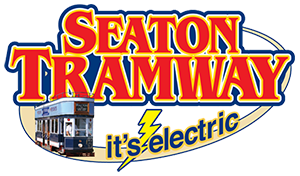1970’s
From September 1969, the entire system had to be dismantled, transported over a hundred miles and partially reassembled before the 1970 holiday season ended. This task fell to just two people, Claude Lane and his assistant Allan Gardner, making some 36 return lorry journeys between Eastbourne and Seaton, driving virtually round the clock.
The newly built Riverside Depot began to fill with equipment, and track laying to the wider gauge of 2ft 9 inches began almost immediately, heading north from Riverside. Car 8 became the first tram to run in passenger service on 28th August 1970. With no overhead wire, power was taken from a battery wagon towed by the tram. The line went as far as Bobsworth Bridge, named after the initial fare of one shilling! Operations ceased during September to allow more equipment to be transported from Eastbourne. Winter activity centred on the regauging of tram bogies to 2ft 9 inch gauge, track work and the erection of traction poles to carry overhead wire.
With the line at Colyford, the first full season was eagerly anticipated, but at that moment Claude Lane suffered a heart attack and died on 2nd April 1971. It was decided to see the project through to completion, as he would have wanted, with Allan Gardner taking over as Managing Director. The company took on three new members of staff and as word spread, volunteers offered their time and help.
Battery operation continued for another two years as the line was developed. A diesel loco was purchased to assist works car 02 in hauling equipment. Two passing loops were installed, Axmouth and Swan's Nest, the first named after the adjacent village across the river and the second after the graceful birds looking on from the adjacent field, enabling trams to operate simultaneously. During 1973 overhead wire and fittings were put in place, and the first tram powered from the overhead ran in September.
An extension to a high profile terminus in the town centre was a necessity to the company's financial health. Seaton Railway had been demolished and so the company was obliged to construct a new route deviating from the track bed at the depot. Land was purchased behind the Holiday Camp, allowing the tramway to enter Harbour Road Car Park. Work continued throughout 1974 but marshy ground slowed progress right up until completion in May 1975.
The final extension to Colyton got underway with an overnight session at Colyford level crossing in November 1975, when staff and volunteers replaced standard gauge rail with tram rail. Disaster struck in 1978 when two years of work was lost in flash floods which swept down the embankment north of Colyford. Subsequent flood defence measures held up the opening of the extension until 1980.

.jpg)

